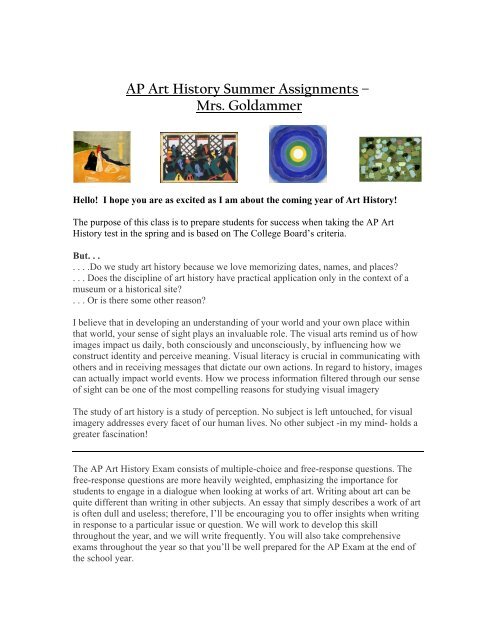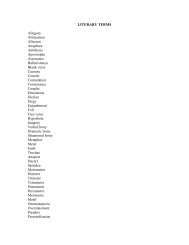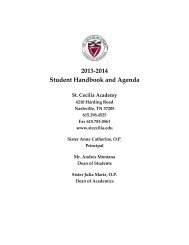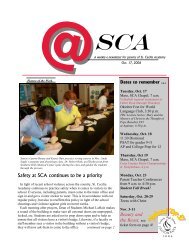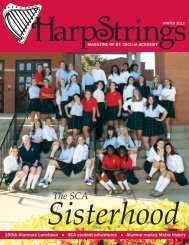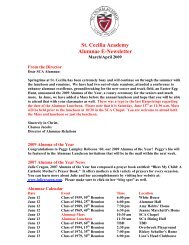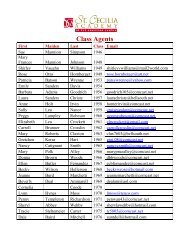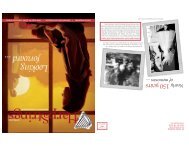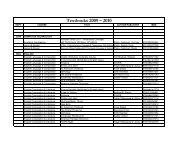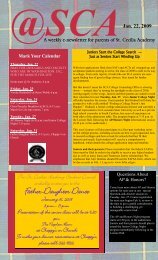AP Art History Summer Assignments - St. Cecilia Academy
AP Art History Summer Assignments - St. Cecilia Academy
AP Art History Summer Assignments - St. Cecilia Academy
You also want an ePaper? Increase the reach of your titles
YUMPU automatically turns print PDFs into web optimized ePapers that Google loves.
<strong>AP</strong> <strong>Art</strong> <strong>History</strong> <strong>Summer</strong> <strong>Assignments</strong> –<br />
Mrs. Goldammer<br />
Hello! I hope you are as excited as I am about the coming year of <strong>Art</strong> <strong>History</strong>!<br />
The purpose of this class is to prepare students for success when taking the <strong>AP</strong> <strong>Art</strong><br />
<strong>History</strong> test in the spring and is based on The College Board’s criteria.<br />
But. . .<br />
. . . .Do we study art history because we love memorizing dates, names, and places?<br />
. . . Does the discipline of art history have practical application only in the context of a<br />
museum or a historical site?<br />
. . . Or is there some other reason?<br />
I believe that in developing an understanding of your world and your own place within<br />
that world, your sense of sight plays an invaluable role. The visual arts remind us of how<br />
images impact us daily, both consciously and unconsciously, by influencing how we<br />
construct identity and perceive meaning. Visual literacy is crucial in communicating with<br />
others and in receiving messages that dictate our own actions. In regard to history, images<br />
can actually impact world events. How we process information filtered through our sense<br />
of sight can be one of the most compelling reasons for studying visual imagery<br />
The study of art history is a study of perception. No subject is left untouched, for visual<br />
imagery addresses every facet of our human lives. No other subject -in my mind- holds a<br />
greater fascination!<br />
The <strong>AP</strong> <strong>Art</strong> <strong>History</strong> Exam consists of multiple-choice and free-response questions. The<br />
free-response questions are more heavily weighted, emphasizing the importance for<br />
students to engage in a dialogue when looking at works of art. Writing about art can be<br />
quite different than writing in other subjects. An essay that simply describes a work of art<br />
is often dull and useless; therefore, I’ll be encouraging you to offer insights when writing<br />
in response to a particular issue or question. We will work to develop this skill<br />
throughout the year, and we will write frequently. You will also take comprehensive<br />
exams throughout the year so that you’ll be well prepared for the <strong>AP</strong> Exam at the end of<br />
the school year.
To prevent you from writing essays that simply describe a work of art, I’ll be<br />
encouraging you to focus on five areas in your writings and in class discussion:<br />
• subject matter<br />
• function<br />
• artistic decision making<br />
• contextual analysis<br />
• cultural impact<br />
Contemplating these five factors will help you to see art as a meaningful part of your life.<br />
(Looking at these five areas won’t just apply to masterpieces but also to images and<br />
objects found in our everyday world that we consider to be art).<br />
The Texts:<br />
-You will need to purchase the following texts which will all be used in your summer<br />
reading.<br />
Gardner's <strong>Art</strong> Through the Ages: A Global <strong>History</strong>, By Helen Gardner, Fred S.<br />
Kleiner, Christin J Mamiya - Cengage Learning (2008) - Hardback - 1104 pages - ISBN<br />
0495093076<br />
Brunelleschi's Dome: How a Renaissance Genius Reinvented<br />
Architecture, By Ross King - Penguin Books (2001) - Paperback - 194 pages - ISBN<br />
0142000159
Michelangelo and the Pope's Ceiling, By Ross King - Penguin USA (2003) - Paperback<br />
- 304 pages - ISBN 0142003697<br />
1. Please read Brunelleschi’s Dome and Michelangelo and The Pope’s Ceiling. As you<br />
read pay particular attention to innovations, new artistic developments and technological<br />
advances. As in an English class, annotate/highlight/take notes, marking key passages<br />
that offer historical information of importance. Also mark key historical figures. You<br />
will be tested over these two books the first week of school, which will constitute your<br />
first test grade of the class.<br />
2. Please read the first three chapters in your Gardner’s textbook (Intro: What is <strong>Art</strong><br />
<strong>History</strong>? P. 1- 13, Ch. 1 <strong>Art</strong> Before <strong>History</strong> P. 15- 28, and Ch. 2 The Ancient Near<br />
East P. 32- 50) and answer the questions on the review sheets that accompany this letter.<br />
This assignment will be collected the very first day of school.<br />
If you have any questions my email is goldammerl@stcecilia.edu<br />
Happy Reading and Have a Wonderful <strong>Summer</strong>!!<br />
Mrs. Goldammer


